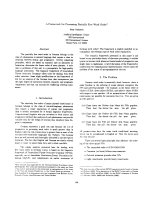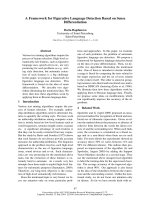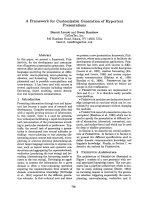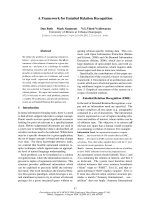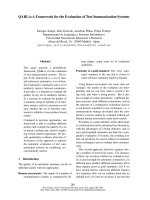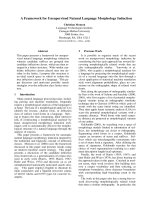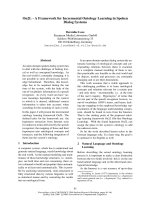Developing your own Franchise - A framework for Vietnamese Franchisors
Bạn đang xem bản rút gọn của tài liệu. Xem và tải ngay bản đầy đủ của tài liệu tại đây (2.06 MB, 122 trang )
VIETNAM NATIONAL UNIVERSITY, HANOI
SCHOOL OF BUSINESS
NGUYEN QUANG TIEP
DEVELOPING YOUR OWN FRANCHISE – A FRAMEWORK FOR
VIETNAMESE FRANCHISORS
MASTER OF BUSINESS ADMINISTRATION THESIS
Hanoi – 2010
VIETNAM NATIONAL UNIVERSITY, HANOI
SCHOOL OF BUSINESS
NGUYEN QUANG TIEP
DEVELOPING YOUR OWN FRANCHISE – A FRAMEWORK FOR
VIETNAMESE FRANCHISORS
Major: Business Administration
Code: 60 34 05
MASTER OF BUSINESS ADMINISTRATION THESIS
Supervisor: Dr. Pham Quy Long,
MBA Ha Nguyen
Hanoi – 2010
i
ACKNOWLEDGEMENT
To me, writing Masters’ Thesis has been an extremely demanding and challenging task
of hard work and effort. This work could not have been completed without the support
of several special people. I would like to thank everyone who has helped and supported
me during the writing of this thesis.
First of all, I would like to express my profound gratitude to my supervisor – Dr. Pham
Quy Long, MBA Ha Nguyen at Hanoi School of Business – Vietnam National
University, who has shared his valuable knowledge and been very good mentor
throughout the writing process. His professional advice and invaluable support have
been highly appreciated during the research process.
And I would like to give my special thanks to my family and my friends for their
support and care for me.
Hanoi School of Business, October 2010
Nguyen Quang Tiep
ii
ABSTRACT
DEVELOPING YOUR OWN FRANCHISE – A FRAMEWORK FOR
VIETNAMESE FRANCHISORS
Nguyen Quang Tiep
MBA Candidate, 2007 – 2009
School of Business - Vietnam National University, Hanoi
Supervisor: Dr. Pham Quy Long, MBA Ha Nguyen
October 2010, 99 pages
In recent years, the average growth rate of franchising businesses in Vietnam is 35%,
five times faster than GDP growth. Total revenue of this sector is 36 million USD, 4
times higher than 5 years ago, and 12 times the revenue in 2000
1
. The expanding trend
in franchising sector can be easily seen on the main streets of big cities like Hanoi, Ho
Chi Minh or Da Nang. Big international franchising brands have come to Vietnam such
as Kentucky Fried Chicken, Pizza Hut, Gloria Jean’s Coffee, Jollibee, Lotteria, The
Body Shop. Franchising has been a favorable method for entrepreneurs to expand their
businesses, from restaurant to airlines service, from rent-a-car to real estates
consultancy. It is forecasted that in the next few years, franchising will be a hot zone
for development, with an annual growth rate of 50%
1
.
However, in the bright picture of franchising in this market, we rarely see Vietnamese
brands. Among 90 franchise systems operating in Vietnam
2
, there are only a few
brands developed and owned by Vietnamese entrepreneurs, and much fewer are
considered to have some early success, namely Pho 24, Kinh Do Bakery… with
humble systems which have not reach the regional competitive scale.
1
Vietnam Franchise Association
2
Nguoi dai bieu nhan dan newspaper,
iii
The thesis concentrates on the framework for Vietnamese franchisors to develop and
manage franchise systems successfully.
In the thesis, the author adopts mainly secondary research methods to domestic and
foreign material sources to find out basic theories about franchising, analyze the
opportunities and challenges to Vietnam franchisors, and develop the appropriate
framework to build franchise systems in Vietnam. The systematical, statistical,
analytical methods are also applied to analyze all collected data.
The thesis is presented in three chapters. The first chapter gives a general overview
about franchising, types and history of franchising, industries most suitable for
franchising and why people want to franchise their businesses. More importantly, the
key success factors for franchisors are listed and illustrated by the case of Jollibee Food
Corporation, Philippines.
Chapter 2 concentrates on studying the franchising market in Vietnam, the macro
environment for franchising and the challenges with which Vietnamese franchisors are
facing. From this chapter, we understand that Vietnam franchising market is just at the
very initial stage and has great potential for development. Despite a favorable
environment, Vietnamese franchisors have not been successful in dominating the
domestic market with their own systems.
In the final chapter, the author suggests a master framework for building franchise
systems in Vietnam, in which the most critical and typical items related to franchise
building are discussed and categorized into 4 main strategic steps: concept, pilot,
expansion and mature.
The findings indicate that Vietnamese entrepreneurs have a great opportunities in
franchising sector, and can overcome the challenges by applying the suggested
framework.
iv
TÓM TẮT
HƯỚNG DẪN XÂY DỰNG HỆ THỐNG NHƯỢNG QUYỀN THƯƠNG MẠI
TẠI VIỆT NAM
Nguyễn Quang Tiệp
Học viên MBA, khóa 2007 – 2009
Khoa Quản trị Kinh doanh, Đại học Quốc gia Hà Nội
Giáo viên hướng dẫn: TS. Phạm Quý Long, ThS. Hà Nguyên
Tháng 10 năm 2010, 99 trang
Trong những năm gần đây, tốc độ tăng trưởng trung bình của ngành nhượng quyền
thương mại là 35%, gấp 5 lần tốc độ tăng GDP. Tổng doanh thu của ngành này là 36
triệu USD, gấp 4 lần doanh thu 5 năm trước, và gấp 12 lần tổng doanh thu năm 2000
3
.
Xu thế phát triển của nhượng quyền thương mại thể hiện rõ nét trên những con phố
chính của các thành phố lớn như Hà Nội, Hồ Chí Minh, Đà Nẵng. Những thương hiệu
nhượng quyền lớn của thế giới đã đến Việt Nam như Gà rán Kentucky, Pizza Hut, cà
phê Gloria Jean’s, Jollibee, Lotteria, The Body Shop Nhượng quyền thương mại
đang là phương thức kinh doanh được nhiều doanh nghiệp lựa chọn để tăng trưởng, từ
nhà hàng cho tới dịch vụ hàng không, từ cho thuê xe cho tới tư vấn bất động sản. Theo
dự báo, trong một vài năm tới, nhượng quyền thương mại sẽ là ngành phát triển nóng
với tốc độ tăng trưởng hàng năm lên tới 50%
3
.
Tuy nhiên, trong bức tranh tươi sáng của thị trường nhượng quyền thương mại, các
thương hiệu Việt Nam còn đóng vai trò rất khiêm tốn. Trong số 90 hệ thống nhượng
quyền đang hoạt động tại Việt Nam
4
, chỉ có một số thương hiệu do người Việt Nam
phát triển và sở hữu, và trong đó chỉ có một số ít được coi là bước đầu thành công như
3
Hiệp hội Nhượng quyền thương mại Việt Nam (VFA)
4
Nguoi dai bieu nhan dan newspaper,
v
Phở 24, Bánh Kinh Đô với những mạng lưới còn khiêm tốn, chưa đạt tới đẳng cấp có
thể cạnh tranh trong khu vực.
Khóa luận tập trung vào việc xây dựng một bộ khung các phương pháp để phát triển và
quản lý hệ thống nhượng quyền thương mại tại Việt Nam.
Trong khóa luận này, tác giả chủ yếu sử dụng phương pháp nghiên cứu thứ cấp, sử
dụng nguồn tài liệu nước ngoài và trong nước để đưa ra những lý thuyết cơ bản về
nhượng quyền, phân tích cơ hội và thách thức cho các nhà nhượng quyền Việt Nam,
đồng thời phát triển các phương pháp phù hợp để xây dựng hệ thống nhượng quyền tại
Việt Nam. Sau đó, người viết sử dụng các phương pháp phân tích, thống kê, hệ thống
để phân tích dữ liệu thu thập được.
Khóa luận được trình bày trong 3 chương. Chương 1 đưa ra tổng quan về nhượng
quyền thương mại, các loại hình và lịch sử nhượng quyền, các ngành phù hợp để
nhượng quyền và lý giải vì sao các doanh nghiệp lại lựa chọn nhượng quyền để phát
triển. Quan trọng hơn, các nhân tố chính quyết định thành công trong nhượng quyền
thương mại đã được nêu ra và minh họa thông qua việc phân tích sự thành công của
Jollibee (Philipin)
Chương 2 tập trung nghiên cứu thị trường nhượng quyền thương mại tại Việt Nam,
môi trường vĩ mô cho nhượng quyền, và các khó khăn mà các nhà nhượng quyền Việt
Nam đang phải đối mặt. Chương này giúp chúng ta hiểu được thị trường nhượng quyền
tại Việt Nam mới đang ở giai đoạn đầu và có tiềm năng phát triển rất lớn. Mặc dù có
được môi trường vĩ mô thuận lợi, các doanh nghiệp Việt Nam vẫn chưa tận dụng được
để phát triển hệ thống nhượng quyền thương mại của riêng mình nhằm chiếm lĩnh thị
trường nội địa.
Trong chương 3, tác giả đề xuất một mô hình khung để xây dựng các hệ thống nhượng
quyền thương mại tại Việt Nam. Trong đó, các công việc quan trọng và đặc trưng nhất
vi
của nhượng quyền thương mại sẽ được bàn luận chi tiết và chia thành bốn bước chiến
lược chủ đạo: đánh giá ý tưởng, thử nghiệm, mở rộng và duy trì.
Kết luận của nghiên cứu cho thấy các doanh nghiệp Việt Nam có cơ hội lớn trong
ngành nhượng quyền thương mại, và có thể vượt qua những thách thức bằng việc áp
dụng mô hình đã được tác giả đề xuất.
vii
TABLE OF CONTENTS
ACKNOWLEDGEMENT i
ABSTRACT ii
TÓM TẮT iv
TABLE OF CONTENTS vii
LIST OF TABLES x
LIST OF FIGURES xi
LIST OF ABBREVIATIONS xii
CHAPTER 1: FRANCHISING OVERVIEW 4
1.1 Franchising definition 4
1.2 Types of Franchising 6
1.2.1 Traditional franchising 6
1.2.2 Business-format franchising 8
1.2.3 The differences between traditional franchising & business-format franchising 9
1.3 Reasons for being a franchisor 10
1.4 Industries suitable for franchising 12
1.5 Common success factors for franchising 15
1.5.1. A successful prototype location (or chain of stores) 15
1.5.2. A strong management team 16
1.5.3. Sufficient capitalization 17
1.5.4. A distinctive and protected trade identity 18
1.5.5. Proprietary and proven methods of operation and management 19
1.5.6. A demonstrated market demand for the product and services 20
1.5.7. Comprehensive training programs for franchisees 21
1.5.8. A set of carefully developed uniform site selection criteria and architectural standards
23
1.5.9. A franchisee profile and screening system 24
1.5.10. An effective system of reporting and record keeping 24
1.5.11. Field support staff 25
1.5.12. Research and development capabilities 25
1.5.13. National, regional, and local advertising, marketing, and public relations programs 25
1.6 Success factors applied to Jollibee case 26
1.6.1 Corporate profile: 27
1.6.2 Analyze the success of JFC by key franchising success factors 27
1.6.2.1. Successful prototype: Good 27
1.6.2.2. Management team: Excellent 28
1.6.2.3. Capitalization: Good 28
1.6.2.4. Trade identity: Good 28
1.6.2.5. Methods of operation and management: Good 29
1.6.2.6. Market demand: Excellent 30
1.6.2.7. Training: Good 31
1.6.2.8. Site selection criteria: Good 31
1.6.2.9. Franchisee screening system: Good 31
1.6.2.10. Reporting and record keeping system 32
viii
1.6.2.11. Field support staff: Good 32
1.6.2.12. R&D: Good 33
1.6.2.13. Marketing & Advertising: Good 34
CHAPTER 2: FRANCHISING IN VIETNAM 35
2.1. An overview of Vietnam franchising market 35
2.2. Franchising environment in Vietnam 39
2.2.1. Political environment 40
2.2.2. Legal environment 42
2.2.3. Economic environment 45
2.2.4. Financial environment 46
2.2.5. Social environment 48
2.3. Challenges to opening a new franchise system in Vietnam 49
2.3.1. Lack of experience 53
2.3.2. Insufficient franchising consultancy 54
CHAPTER 3: FRAMEWORK FOR BUILDING A FRANCHISE SYSTEM 56
3.1. Framework introduction 56
3.2. Concept stage 57
3.2.1. Industry assessment 57
3.2.1.1. Production and distribution occur in limited geographic markets. 57
3.2.1.2. Physical locations are helpful to serving customers. 59
3.2.1.3. Local market knowledge is important to performance. 59
3.2.1.4. Brand name reputation is a valuable competitive advantage. 60
3.2.1.5. The level of standardization and codification of the process of creating and
delivering the product or service is high. 60
3.2.1.6. The operation is labor intensive. 61
3.2.1.7. Outlets are not terribly costly to establish. 62
3.2.2. Concept assessment 62
3.2.2.1. Valuable system to sell 63
3.2.2.2. Transferable concept 63
3.2.2.3. Large pool of potential franchisees 65
3.3. Pilot stage 67
3.3.1. Site selection 67
3.3.1.1. Density of the primary target audience 68
3.3.1.2. Traffic volume 68
3.3.1.3. Traffic patterns 68
3.3.1.4. Site visibility 69
3.3.1.5. Traffic flow to the site 69
3.3.1.6. Complementary versus contracdictory neighbors 69
3.3.2. Trade identity development & protection 72
3.3.3. Operations manual 72
3.3.3.1. Guidelines for preparation of the manual 72
3.3.3.2. Suggested outline for the operations manual of a franchisor 74
3.4. Expansion stage 77
3.4.1. Pricing franchise 77
3.4.1.1. Franchise fee 77
ix
3.4.1.2. Royalty rate 79
3.4.2. Franchise agreement preparation 81
3.4.2.1. Rights granted 82
3.4.2.2. Territory 82
3.4.2.3. Services to be provided by the franchisor 82
3.4.2.4. Supplying the products 83
3.4.2.5. Franchise, royalty and other fees payable to franchisor and reporting 84
3.4.2.6. Quality control 85
3.4.2.7. Protection of intellectual property 85
3.4.2.8. Termination of the franchise agreement 86
3.4.3. Franchisee recruitment 86
3.4.3.1. Industry experience 87
3.4.3.2. Net worth requirements 87
3.4.3.3. Psychological attributes 88
3.5. Mature stage 88
3.5.1. Monitoring quality 89
3.5.1.1. Field support 89
3.5.1.2. External service audits 90
3.5.1.3. Peer review 91
3.5.1.4. Analytical tools 91
3.5.1.5. Customer feedback 92
3.5.2. Monitoring franchisee financial reporting 92
3.5.2.1. Point of sale systems 93
3.5.2.2. Financial reporting 94
3.5.2.3. Financial audits 94
CONCLUSION 96
LIST OF REFERENCES 98
APPENDIX 1 100
x
LIST OF TABLES
Item
Table Description Page
1.1 Main differences between 2 types of Franchising 9
1.2 Top ten industries for franchising in percent of franchisors 14
1.3 Average number of years franchisors are in operation before
franchising for selected industries
17
1.4 Average annual outlet turnover rates for selected industries 22
1.5 Portion of a sample training agenda from a restaurant franchisor
23
1.6 Average advertising fee by industry 27
2.1 Vietnam franchising market compared to other ASEAN
countries
37
2.2 Vietnam franchising in 2008 39
2.3 Franchising market size of biggest cities in ASEAN 40
2.4 Franchising business environment in Vietnam 40
2.5 New companies registered by year 43
2.6 Items required for disclosure in a UFOC 44
2.7 Annual GDP growth rate & GDP per capita of Vietnam (‘90-
‘09)
46
2.8 Selected information depicting Vietnam infrastructure 46
2.9 Foreign franchising brands registered in Vietnam 50
3.1 Industry & concept assessment template 67
3.2 Site selection template 71
3.3 Sample operations manual outline 75
xi
LIST OF FIGURES
Item
Figure Description Page
1.1 Franchise definition illustration 6
1.2 Percentage of franchised outlets by size of the system 11
1.3 Franchise systems with at least one active franchised unit during
the period of 2001-2005
11
1.4 Strategic options for business growth 13
1.5 Franchise systems reporting units during 2001-2005 15
1.6 Maximum total initial investment by industry 18
1.7 Average first 3 years net income for franchising concepts
founded 2000-2004
19
1.8 Sample operations manual provisions concerning garbage and
refuse
20
1.9 Purchase behavior quick screen 25
1.10
Jollibee logo 38
1.11
Jollibee strategy 31
1.12
Jollibee’s R&D process 34
2.1 Vietnam franchising market 36
2.2 Vietnam franchise sector structure 39
2.3 Vietnam inflation rate 48
2.4 VND/USD exchange rate 48
3.1 Framework for building a franchise system 57
xii
LIST OF ABBREVIATIONS
AMACOM American Management Association
ASEAN Association of Southeast Asian Nations
BOTP Basic Operations Training Program
CIA Central Intelligence Agency
FDI Foreign Direct Investment
FTC Federal Trade Commission
GDP Gross Domestic Products
HCMC Ho Chi Minh City
KFC Kentucky Fried Chicken
JFC Jollibee Foods Corporation
PERC Political & Economic Risk Consulting Organization
R&D Research and Development
TTC Tony Tan Caktiong
VND Vietnam Dong
VFA Vietnam Franchising Association
UFOC Uniform Franchise Offering Circular
U.S United States
USA United States of America
USD United States Dollars
USDOC United States Department of Commerce
WFA World Franchising Council
1
INTRODUCTION
The emergency and objectives of the research
The reform of Vietnam has been taking place totally and deeply in many fields. The
event that Vietnam became the official member of the World Trade Organization
(WTO) put an important mark in the integrating process into the world economy.
Vietnam’s economy has grown fast, in the last twenty years GDP of Vietnam increased
by over 7% on average.
5
The franchising sector first came to Vietnam in early 1990s, and after 15 years, the
total revenue in this sector grew 24 times, from 1.5 million USD in 1996 to 36 million
USD in 2010 (estimated).
6
However, the major portion of this market is dominated by
foreign brands. Vietnamese companies haven’t succeeded in leveraging the local
market understanding to make a successful franchise system in order to directly
compete with international franchise systems in domestic market.
With the objective to contribute to finding a suitable method for developing franchise
systems in Vietnam, I have chosen the topic “FRAMEWORK FOR BUILDING
FRANCHISE SYSTEMS IN VIETNAM”.
The objectives of the research are to:
- Present an overview of franchising and provide the key franchising success factors
- Provide an analysis of the franchising market in Vietnam
- Recommend a master framework for Vietnamese franchisors to build their own
franchise systems.
5
The CIA World Fact Book 2009
6
Vietnam Franchise Association
2
Subject and scope
The subject concentrates on the framework for franchise system development. In
which, it will specially suggests the activities needed to develop a business-format
franchise in Vietnam.
Research methodology:
In the thesis, the author adopts mainly secondary research methods to domestic and
foreign material sources to find out basic theories about franchising, analyze the
opportunities and challenges to Vietnam franchisors, and develop the appropriate
framework to build franchise systems in Vietnam. The systematical, statistical,
analytical methods are also applied to analyze all collected data.
The structure of the thesis
The thesis is presented in three chapters in which the first chapter will give basic
definitions and most general theories about the researched problem of this thesis. The
second chapter will analyze the current situation of Vietnamese market and give
judgements about the opportunities and challenges for Vietnamese franchisors. The
third chapter will give some recommendations about the master framework to build a
franchise system in Vietnam.
Chapter 1: Franchising overview
The first chapter gives a general overview about franchising, types and history of
franchising, industries most suitable for franchising and why people want to franchise
their businesses. More importantly, the key success factors for franchisors are listed
and illustrated by the case of Jollibee Food Corporation, Philippines.
3
Chapter 2: Franchising in Vietnam
Chapter 2 concentrates on studying the franchising market in Vietnam, the macro
environment for franchising and the challenges with which Vietnamese franchisors are
facing. From this chapter, we understand that Vietnam franchising market is just at the
very initial stage and has great potential for development. Despite a favorable
environment, Vietnamese franchisors have not been successful in dominating the
domestic market with their own systems.
Chapter 3: Framework for building your own franchise
In the final chapter, the author suggests a master framework for building franchise
systems in Vietnam, in which the most critical and typical items related to franchise
building are discussed and categorized into 4 main strategic steps: concept, pilot,
expansion and mature.
4
CHAPTER 1: FRANCHISING OVERVIEW
1.1 Franchising definition
According to the American Heritage Dictionary of the English Language, the word
franchise comes from the old French word franche, which means free or exempt.
7
In
medieval times, a franchise was a right or privilege granted by a sovereign power –
king, church, or local government. Sovereigns granted franchises for various activities,
such as building roads, holding fairs, organizing markets, or for the right to maintain
civil order and collect taxes. In essence, the sovereign gave an individual or group of
individuals the monopoly rights over a particular activity in a particular location for a
certain period of time. In most cases, the grantee was required to make a payment to
the sovereign power for this right or privilege, usually in the form of a share of the
product or profit. That payment was called a royalty, a term still in use to this day.
The meaning of this word is similarly reflected in many laws and definitions around
the world.
According to International Franchise Association, “a franchise is the agreement or
license between two legally independent parties which gives:
• a person or group of people (franchisee) the right to market a product or service
using the trademark or trade name of another business (franchisor)
• the franchisee the right to market a product or service using the operating methods
of the franchisor
• the franchisee the obligation to pay the franchisor fees for these rights
7
American Heritage Dictionary of the English Language, Fourth Edition (2000), Boston, Houghton Mifflin
Company.
5
• the franchisor the obligation to provide rights and support to franchisees”
8
According to the Federal Trade Commission (FTC), the body that has jurisdiction in
the United States over federal disclosure rules for franchisors, three elements must be
present for a business relationship to be deemed a franchise. First, the franchisor must
license a trade name and trademark that the franchisee operates under, or the franchisee
must sell products or services identified by this trademark. Second, the franchisor must
exert significant control over the operation of the franchisee or provide significant
assistance to the franchisee. Third, the franchisee must pay at least $500 to the
franchisor at any time before or within the first six months of operation.
9
In Vietnam, although franchise business started much later than other countries, we
have already defined this in 2005 Commercial law as follow: “Franchising is a business
activity in which the franchisor allows and requests the franchisee to buy/sell products,
provide services according to following conditions:
1. The buying/selling of products, providing of services is carried out under the
business processes set by the franchisor, and associated with franchisor’s trade
mark, trade name, know-how, slogan, logo and advertisement.
2. The franchisor has the rights to control and support franchisee in running the
franchise business”
10
Unfortunately, the definition in Vietnam Commercial law does not mention about fee
for the franchised rights, which is one of the main motives for the fast development of
franchising nowadays.
From the above mentioned 3 definitions, a diagram can be drawn to illustrate
franchising as below:
8
IFA Educational Foundation (2001): “An introduction to Franchising” (P.5)
9
Federal Trade Commission (1979):
10
Vietnam Commercial law (2005), Article 284
6
Figure 1.1: Franchise definition illustration
(Source: IFA Educational Foundation (2001): “An introduction to Franchising”)
In later parts, the author will take a deeper look at the elements of this diagram such as
finance, advertising and marketing, training, royalty fees…
1.2 Types of Franchising
The broad category of franchising is made up of two different business models:
traditional franchising (also known as product franchising) and business format
franchising.
1.2.1 Traditional franchising
Traditional franchising is an arrangement in which one party, a franchisor, develops a
trade name and licenses it to another party, a franchisee. The product franchisee
contracts for the use of the name to deliver products or services to end customers for a
certain time period at a certain location.
11
As the name suggests, traditional franchising is the oldest form of modern franchising.
By most accounts, it can be traced back in the U.S. at least to the mid-1800s when the
McCormick Harvesting Machine Company and the Singer Sewing Machines Company
sold their products through sales agents who were given exclusive sales territories.
12
11
Scott A. Shane (2005): “From Ice cream to the Internet – Using franchising to drive the growth and profits of
your business” – Pearson Education, Inc
12
Thomas S. Dicke (1992): “Franchising in the America: The development of a business method, 1840 – 1980”.
Chapel Hill, NC: University of North Carolina Press
7
Initially, these firms, like others who used such agents at the time, imposed few
restrictions or qualifications on their agents and exerted very little control over them.
Over time, however, both companies found they needed more control over these sales
agents if they were to protect their respective reputations and brands. The McCormick
Company responded by establishing company owned branch houses throughout the
U.S. and Canada. These branch houses were given oversight responsibilities for the
sales agents in their territories.
As a result, McCormick was able to systematize procedures and communications with
its agents, thereby transforming them into what one would now call “dealers.” As for
the Singer Company, it addressed the need for control by converting many of the
independent agencies into company outlets. More importantly, it devised a series of
recommendations for the remaining agents as to how the offices should be run and, for
the first time, required detailed financial reporting from these agents. The contracts and
methods of control that Singer developed at the time are largely recognized as the
forerunners of the modern franchise agreement. Traditional franchising today is
comprised largely of automobile dealerships, gasoline service stations, and soft-drink
bottlers.
In all of these businesses, the franchisor is a manufacturer who sells finished or semi-
finished products to its dealers/franchisees. In turn, the franchisees resell these products
to consumers or other firms in the distribution chain. Because the franchisor’s product
is sold to its franchisees, the franchisor’s profits from its dealer network flow from the
markups it earns on these products. In contrast to what occurs in business-format
franchising, as described below, traditional franchisees do not pay running royalties on
their sales.
In Vietnam, the most phenomenal and recognizable Vietnamese traditional franchise is
the Trung Nguyen coffee which spread out all over the country in the late 1990s.
8
1.2.2 Business-format franchising
Business-format franchising is a type of franchising in which the franchisor primarily
sells a way of doing business (i.e., a business format) to its franchisees. A business-
format franchise thus “includes not only the product, service, and trademark, but the
entire business format itself – a marketing strategy and plan, operating manuals and
standards, quality control, and continuing two-way communication”
13
The first true business-format franchise system was created by Martha
Mathilda Harper
14
. This entrepreneur developed her network of Harper Beauty Shops
from the early 1890s onward using a business model that included all of the
components of a business format as described by the USDOC, and more. But though
she grew her network to more than 500 shops in the U.S., Canada, and Europe by the
mid-1920s, Mathilda Harper unfortunately did not leave a lasting mark on franchising.
It was only until the 1950s, with the advent of chains such as Burger King and
McDonald’s, and the economic boom of the post–World War II era, that business-
format franchising fully came into its own in the U.S. and Canada, and throughout
much of the rest of the world.
Business-format franchising today encompasses a very large number of firms that
provide a wide array of goods and services: automotive products and services, business
aids and services, construction and maintenance, childcare services, and non-food
retailing as well as the more visible hotel, fast-food, and car rental franchises. In
exchange for the business format, franchisees typically pay a relatively small lump-
sum fixed fee at the beginning of the contract period and pay running royalties that are
usually calculated as a fixed percentage of the franchisee’s sales revenues. Business-
format franchisees also often contribute an additional fraction of their sales or revenues
13
United States Department of Commerce (USDOC) (1988): “Franchising in the Economy”
14
Jane R. Plitt (2000): “Martha Mathilda Harper and the American dream”, New York Syracuse University Press
9
toward an advertising fund for the chain as a whole. Presumably, the advertising
carried out with these funds benefits all franchisees and thereby benefits the franchisor
as well.
This business-format franchising has become the most popular type of franchising in
the world today, and also in Vietnam. We have seen many world’s famous franchising
brands such as KFC, Pizza Hut, Lotteria, Jollibee coming to Vietnam since 1990s, and
the rise of local brands such as Pho 24, Kinh Do Bakery…
1.2.3 The differences between traditional franchising & business-format
franchising
The major differences between traditional franchising and business-format franchising
can be summarized in the table below:
Table 1.1: Main differences between 2 types of Franchising
Category Traditional
franchising
Business-format
franchising
Franchisee can use Franchisor’s trade name,
logo
Franchisor offers an operating system to
franchisee
Uniformity in the operations of franchise
outlets
Franchisee contribute to whole system’s
marketing and advertising
Compensation to franchisor Product whole
sale to
franchisee
Royalty fee
(Source: author)
10
1.3 Reasons for being a franchisor
There are a wide variety of reasons cited by successful franchisors as to why
franchising has been selected as a method of growth and distribution.
15
Through franchising, they are able to:
· Obtain operating efficiencies and economies of scale: Figure 1.2 below shows the
relationship between the size of a chain in the number of outlets and the reliance
on franchising. It indicates that larger chains have a greater reliance on franchising
than smaller ones
Figure 1.2: % of franchised outlets by size of the system
Source: Adapted from data contained in R. Bond (2004): “Bond’s Franchise Guide”,
Oakland, CA: Sourcebook Publications
· Increase market share and build brand equity: According to a recent research by
International Franchise Association, 47% of all franchise systems have more than
15
Andrew J. Sherman (2004): “Franchising & Licensing – Two powerful ways to grow your business in any
economy”, American Management Association (AMACOM)
11
51 franchised units, and only 25% of them have less than 10 franchised units (see
Figure 1.3 below)
Figure 1.3: Franchise systems with at least one active franchised unit during
the period of 2001-2005.
(Sample size: 1,675 franchise systems)
Source: International Franchise Association (3/2007): “The Profile of Franchising”
· Use the power of franchising as a system to get and keep more and more
customers-building customer loyalty.
· Reach the targeted consumer more effectively through cooperative advertising
and promotion.
· Sell products and services to a dedicated distributor network.
· Replace the need for internal personnel with motivated owner/operators.
· Shift the primary responsibility for site selection, employee training and personnel
management, local advertising, and other administrative concerns to the
franchisee, licensee, or joint venture partner with the guidance or assistance of the
franchisor.

